Deck 10: Basic Macroeconomic Relationships
سؤال
سؤال
سؤال
سؤال
سؤال
سؤال
سؤال
سؤال
سؤال
سؤال
سؤال
سؤال
سؤال
سؤال
سؤال
سؤال
سؤال
سؤال
سؤال
سؤال
سؤال
سؤال
سؤال
سؤال
سؤال
سؤال
سؤال
سؤال
سؤال
سؤال
سؤال
سؤال
سؤال
سؤال
سؤال
سؤال
سؤال
سؤال
سؤال
سؤال
سؤال
سؤال
سؤال
سؤال
سؤال
سؤال
سؤال
سؤال
سؤال
سؤال
سؤال
سؤال
سؤال
سؤال
سؤال
سؤال
سؤال
سؤال
سؤال
سؤال
سؤال
سؤال
سؤال
سؤال
سؤال
سؤال
سؤال
سؤال
سؤال
سؤال
سؤال
سؤال
سؤال
سؤال
سؤال
سؤال
سؤال
سؤال
سؤال
سؤال

فتح الحزمة
قم بالتسجيل لفتح البطاقات في هذه المجموعة!
Unlock Deck
Unlock Deck
1/233
العب
ملء الشاشة (f)
Deck 10: Basic Macroeconomic Relationships
1
The consumption schedule shows
A) that the MPC increases in proportion to GDP.
B) that households consume more when interest rates are low.
C) that consumption depends primarily on the level of business investment.
D) the amounts households intend to consume at various possible levels of aggregate income.
A) that the MPC increases in proportion to GDP.
B) that households consume more when interest rates are low.
C) that consumption depends primarily on the level of business investment.
D) the amounts households intend to consume at various possible levels of aggregate income.
the amounts households intend to consume at various possible levels of aggregate income.
2
The most important determinant of consumption and saving is the
A) level of bank credit.
B) level of income.
C) interest rate.
D) price level.
A) level of bank credit.
B) level of income.
C) interest rate.
D) price level.
level of income.
3
The consumption schedule is such that
A) both the APC and the MPC increase as income rises.
B) the APC is constant and the MPC declines as income rises.
C) the MPC is constant and the APC declines as income rises.
D) the MPC and the APC must be equal at all levels of income.
A) both the APC and the MPC increase as income rises.
B) the APC is constant and the MPC declines as income rises.
C) the MPC is constant and the APC declines as income rises.
D) the MPC and the APC must be equal at all levels of income.
the MPC is constant and the APC declines as income rises.
4
With a marginal propensity to save of 0.4, the marginal propensity to consume will be
A) 1.0 minus 0.4.
B) 0.4 minus 1.0.
C) the reciprocal of the MPS.
D) 0.4.
A) 1.0 minus 0.4.
B) 0.4 minus 1.0.
C) the reciprocal of the MPS.
D) 0.4.

فتح الحزمة
افتح القفل للوصول البطاقات البالغ عددها 233 في هذه المجموعة.
فتح الحزمة
k this deck
5
If Carol's disposable income increases from $1,200 to $1,700 and her level of saving increases from minus $100 to a plus $100, her marginal propensity to
A) save is three-fifths.
B) consume is one-half.
C) consume is three-fifths.
D) consume is two-fifths.
A) save is three-fifths.
B) consume is one-half.
C) consume is three-fifths.
D) consume is two-fifths.

فتح الحزمة
افتح القفل للوصول البطاقات البالغ عددها 233 في هذه المجموعة.
فتح الحزمة
k this deck
6
As disposable income goes up, the
A) average propensity to consume falls.
B) average propensity to save falls.
C) volume of consumption declines absolutely.
D) volume of investment diminishes.
A) average propensity to consume falls.
B) average propensity to save falls.
C) volume of consumption declines absolutely.
D) volume of investment diminishes.

فتح الحزمة
افتح القفل للوصول البطاقات البالغ عددها 233 في هذه المجموعة.
فتح الحزمة
k this deck
7
A decline in disposable income
A) increases consumption by moving upward along a specific consumption schedule.
B) decreases consumption because it shifts the consumption schedule downward.
C) decreases consumption by moving downward along a specific consumption schedule.
D) increases consumption because it shifts the consumption schedule upward.
A) increases consumption by moving upward along a specific consumption schedule.
B) decreases consumption because it shifts the consumption schedule downward.
C) decreases consumption by moving downward along a specific consumption schedule.
D) increases consumption because it shifts the consumption schedule upward.

فتح الحزمة
افتح القفل للوصول البطاقات البالغ عددها 233 في هذه المجموعة.
فتح الحزمة
k this deck
8
The 45-degree line on a graph relating consumption and income shows
A) all the points where the MPC is constant.
B) all the points at which saving and income are equal.
C) all the points at which consumption and income are equal.
D) the amounts households will plan to save at each possible level of income.
A) all the points where the MPC is constant.
B) all the points at which saving and income are equal.
C) all the points at which consumption and income are equal.
D) the amounts households will plan to save at each possible level of income.

فتح الحزمة
افتح القفل للوصول البطاقات البالغ عددها 233 في هذه المجموعة.
فتح الحزمة
k this deck
9
The consumption schedule is drawn on the assumption that as income increases, consumption will
A) be unaffected.
B) increase absolutely but remain constant as a percentage of income.
C) increase absolutely but decline as a percentage of income.
D) increase both absolutely and as a percentage of income.
A) be unaffected.
B) increase absolutely but remain constant as a percentage of income.
C) increase absolutely but decline as a percentage of income.
D) increase both absolutely and as a percentage of income.

فتح الحزمة
افتح القفل للوصول البطاقات البالغ عددها 233 في هذه المجموعة.
فتح الحزمة
k this deck
10
The consumption schedule shows
A) a direct relationship between aggregate consumption and accumulated wealth.
B) a direct relationship between aggregate consumption and aggregate income.
C) an inverse relationship between aggregate consumption and accumulated financial wealth.
D) an inverse relationship between aggregate consumption and the price level.
A) a direct relationship between aggregate consumption and accumulated wealth.
B) a direct relationship between aggregate consumption and aggregate income.
C) an inverse relationship between aggregate consumption and accumulated financial wealth.
D) an inverse relationship between aggregate consumption and the price level.

فتح الحزمة
افتح القفل للوصول البطاقات البالغ عددها 233 في هذه المجموعة.
فتح الحزمة
k this deck
11
The consumption schedule directly relates
A) consumption to the level of disposable income.
B) saving to the level of disposable income.
C) disposable income to domestic income.
D) consumption to saving.
A) consumption to the level of disposable income.
B) saving to the level of disposable income.
C) disposable income to domestic income.
D) consumption to saving.

فتح الحزمة
افتح القفل للوصول البطاقات البالغ عددها 233 في هذه المجموعة.
فتح الحزمة
k this deck
12
The consumption and saving schedules reveal that the
A) MPC is greater than zero but less than one.
B) MPC and APC are equal at the point where the consumption schedule intersects the 45- degree line.
C) APS is positive at all income levels.
D) MPC is equal to or greater than one at all income levels.
A) MPC is greater than zero but less than one.
B) MPC and APC are equal at the point where the consumption schedule intersects the 45- degree line.
C) APS is positive at all income levels.
D) MPC is equal to or greater than one at all income levels.

فتح الحزمة
افتح القفل للوصول البطاقات البالغ عددها 233 في هذه المجموعة.
فتح الحزمة
k this deck
13
The MPC can be defined as that fraction of a
A) change in income that is not spent.
B) change in income that is spent.
C) given total income that is not consumed.
D) given total income that is consumed.
A) change in income that is not spent.
B) change in income that is spent.
C) given total income that is not consumed.
D) given total income that is consumed.

فتح الحزمة
افتح القفل للوصول البطاقات البالغ عددها 233 في هذه المجموعة.
فتح الحزمة
k this deck
14
The APC can be defined as the fraction of a
A) change in income that is not spent.
B) change in income that is spent.
C) specific level of total income that is not consumed.
D) specific level of total income that is consumed.
A) change in income that is not spent.
B) change in income that is spent.
C) specific level of total income that is not consumed.
D) specific level of total income that is consumed.

فتح الحزمة
افتح القفل للوصول البطاقات البالغ عددها 233 في هذه المجموعة.
فتح الحزمة
k this deck
15
The most important determinant of consumer spending is
A) the level of household borrowing.
B) consumer expectations.
C) the stock of wealth.
D) the level of income.
A) the level of household borrowing.
B) consumer expectations.
C) the stock of wealth.
D) the level of income.

فتح الحزمة
افتح القفل للوصول البطاقات البالغ عددها 233 في هذه المجموعة.
فتح الحزمة
k this deck
16
Which of the following is correct?
A) APC + APS = 1.
B) APC + MPS = 1.
C) APS + MPC = 1.
D) APS + MPS = 1.
A) APC + APS = 1.
B) APC + MPS = 1.
C) APS + MPC = 1.
D) APS + MPS = 1.

فتح الحزمة
افتح القفل للوصول البطاقات البالغ عددها 233 في هذه المجموعة.
فتح الحزمة
k this deck
17
The size of the MPC is assumed to be
A) less than zero.
B) greater than one.
C) greater than zero but less than one.
D) two or more.
A) less than zero.
B) greater than one.
C) greater than zero but less than one.
D) two or more.

فتح الحزمة
افتح القفل للوصول البطاقات البالغ عددها 233 في هذه المجموعة.
فتح الحزمة
k this deck
18
The relationship between consumption and disposable income is such that
A) an inverse and stable relationship exists between consumption and income.
B) a direct, but very volatile, relationship exists between consumption and income.
C) a direct and relatively stable relationship exists between consumption and income.
D) the two are usually equal.
A) an inverse and stable relationship exists between consumption and income.
B) a direct, but very volatile, relationship exists between consumption and income.
C) a direct and relatively stable relationship exists between consumption and income.
D) the two are usually equal.

فتح الحزمة
افتح القفل للوصول البطاقات البالغ عددها 233 في هذه المجموعة.
فتح الحزمة
k this deck
19
The APC is calculated as
A) change in consumption/change in income.
B) consumption/income.
C) change in income/change in consumption.
D) income/consumption.
A) change in consumption/change in income.
B) consumption/income.
C) change in income/change in consumption.
D) income/consumption.

فتح الحزمة
افتح القفل للوصول البطاقات البالغ عددها 233 في هذه المجموعة.
فتح الحزمة
k this deck
20
As disposable income increases, consumption
A) and saving both increase.
B) and saving both decrease.
C) decreases and saving increases.
D) increases and saving decreases.
A) and saving both increase.
B) and saving both decrease.
C) decreases and saving increases.
D) increases and saving decreases.

فتح الحزمة
افتح القفل للوصول البطاقات البالغ عددها 233 في هذه المجموعة.
فتح الحزمة
k this deck
21
At the point where the consumption schedule intersects the 45-degree line,
A) the MPC is 1.00.
B) the APC is 1.00.
C) saving is equal to consumption.
D) the economy is in equilibrium.
A) the MPC is 1.00.
B) the APC is 1.00.
C) saving is equal to consumption.
D) the economy is in equilibrium.

فتح الحزمة
افتح القفل للوصول البطاقات البالغ عددها 233 في هذه المجموعة.
فتح الحزمة
k this deck
22
If Trent's MPC is 0.80, this means that he will
A) spend eight-tenths of any increase in his disposable income.
B) spend eight-tenths of any level of disposable income.
C) break even when his disposable income is $8,000.
D) save two-tenths of any level of disposable income.
A) spend eight-tenths of any increase in his disposable income.
B) spend eight-tenths of any level of disposable income.
C) break even when his disposable income is $8,000.
D) save two-tenths of any level of disposable income.

فتح الحزمة
افتح القفل للوصول البطاقات البالغ عددها 233 في هذه المجموعة.
فتح الحزمة
k this deck
23
In contrast to investment, consumption is
A) relatively unstable.
B) relatively stable.
C) measurable.
D) unmeasurable.
A) relatively unstable.
B) relatively stable.
C) measurable.
D) unmeasurable.

فتح الحزمة
افتح القفل للوصول البطاقات البالغ عددها 233 في هذه المجموعة.
فتح الحزمة
k this deck
24
(Advanced analysis) If the equation for the consumption schedule is C = 20 + 0.8Y, where C is consumption and Y is disposable income, then the average propensity to consume is 1 when
Disposable income is
A) $80.
B) $100.
C) $120.
D) $160.
Disposable income is
A) $80.
B) $100.
C) $120.
D) $160.

فتح الحزمة
افتح القفل للوصول البطاقات البالغ عددها 233 في هذه المجموعة.
فتح الحزمة
k this deck
25
(Advanced analysis) The equation C = 35 + 0.75Y, where C is consumption and Y is disposable income, shows that
A) households will consume three-fourths of whatever level of disposable income they receive.
B) households will consume $35 if their disposable income is zero and will consume three- fourths of any increase in disposable income they receive.
C) there is an inverse relationship between disposable income and consumption.
D) households will save $35 if their disposable income is zero and will consume three-fourths of any increase in disposable income they receive.
A) households will consume three-fourths of whatever level of disposable income they receive.
B) households will consume $35 if their disposable income is zero and will consume three- fourths of any increase in disposable income they receive.
C) there is an inverse relationship between disposable income and consumption.
D) households will save $35 if their disposable income is zero and will consume three-fourths of any increase in disposable income they receive.

فتح الحزمة
افتح القفل للوصول البطاقات البالغ عددها 233 في هذه المجموعة.
فتح الحزمة
k this deck
26
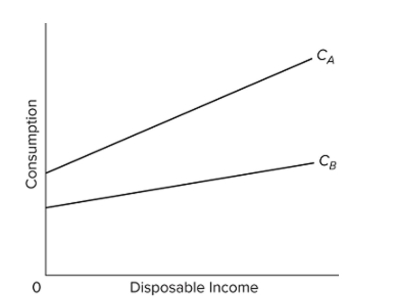 Refer to the given diagram, which shows consumption schedules for economies A and B. We can say that the
Refer to the given diagram, which shows consumption schedules for economies A and B. We can say that theA) MPC is greater in B than in A.
B) APC at any given income level is greater in B than in A.
C) MPS is smaller in B than in A.
D) MPC is greater in A than in B.

فتح الحزمة
افتح القفل للوصول البطاقات البالغ عددها 233 في هذه المجموعة.
فتح الحزمة
k this deck
27
(Advanced analysis) Assume the following consumption schedule: C = 20 + 0.9Y, where C is consumption and Y is disposable income. At an $800 level of disposable income, the level of saving is
A) $180.
B) $740.
C) $60.
D) $18.
A) $180.
B) $740.
C) $60.
D) $18.

فتح الحزمة
افتح القفل للوصول البطاقات البالغ عددها 233 في هذه المجموعة.
فتح الحزمة
k this deck
28
Suppose a family's consumption exceeds its disposable income. This means that its
A) MPC is greater than 1.
B) MPS is negative.
C) APC is greater than 1.
D) APS is positive.
A) MPC is greater than 1.
B) MPS is negative.
C) APC is greater than 1.
D) APS is positive.

فتح الحزمة
افتح القفل للوصول البطاقات البالغ عددها 233 في هذه المجموعة.
فتح الحزمة
k this deck
29
Which of the following relations is not correct?
A) 1 − MPC = MPS.
B) APS + APC = 1.
C) MPS = MPC + 1.
D) MPC + MPS = 1.
A) 1 − MPC = MPS.
B) APS + APC = 1.
C) MPS = MPC + 1.
D) MPC + MPS = 1.

فتح الحزمة
افتح القفل للوصول البطاقات البالغ عددها 233 في هذه المجموعة.
فتح الحزمة
k this deck
30
(Advanced analysis) Assume the following consumption schedule: C = 20 + 0.9Y, where C is consumption and Y is disposable income. The MPC is
A) 0.45.
B) 0.20.
C) 0.50.
D) 0.90.
A) 0.45.
B) 0.20.
C) 0.50.
D) 0.90.

فتح الحزمة
افتح القفل للوصول البطاقات البالغ عددها 233 في هذه المجموعة.
فتح الحزمة
k this deck
31
Dissaving means
A) the same thing as disinvesting.
B) that households are spending more than their current incomes.
C) that saving and investment are equal.
D) that disposable income is less than zero.
A) the same thing as disinvesting.
B) that households are spending more than their current incomes.
C) that saving and investment are equal.
D) that disposable income is less than zero.

فتح الحزمة
افتح القفل للوصول البطاقات البالغ عددها 233 في هذه المجموعة.
فتح الحزمة
k this deck
32
Dissaving occurs where
A) income exceeds consumption.
B) saving exceeds consumption.
C) consumption exceeds income.
D) saving exceeds income.
A) income exceeds consumption.
B) saving exceeds consumption.
C) consumption exceeds income.
D) saving exceeds income.

فتح الحزمة
افتح القفل للوصول البطاقات البالغ عددها 233 في هذه المجموعة.
فتح الحزمة
k this deck
33
One can determine the amount of any level of total income that is consumed by
A) multiplying total income by the slope of the consumption schedule.
B) multiplying total income by the APC.
C) subtracting the MPS from total income.
D) multiplying total income by the MPC.
A) multiplying total income by the slope of the consumption schedule.
B) multiplying total income by the APC.
C) subtracting the MPS from total income.
D) multiplying total income by the MPC.

فتح الحزمة
افتح القفل للوصول البطاقات البالغ عددها 233 في هذه المجموعة.
فتح الحزمة
k this deck
34
The MPC for an economy is
A) the slope of the consumption schedule or line.
B) the slope of the savings schedule or line.
C) 1 divided by the slope of the consumption schedule or line.
D) 1 divided by the slope of the savings schedule or line.
A) the slope of the consumption schedule or line.
B) the slope of the savings schedule or line.
C) 1 divided by the slope of the consumption schedule or line.
D) 1 divided by the slope of the savings schedule or line.

فتح الحزمة
افتح القفل للوصول البطاقات البالغ عددها 233 في هذه المجموعة.
فتح الحزمة
k this deck
35
The saving schedule is drawn on the assumption that as income increases,
A) saving will decline absolutely and as a percentage of income.
B) saving will increase absolutely but remain constant as a percentage of income.
C) saving will increase absolutely but decline as a percentage of income.
D) saving will increase absolutely and as a percentage of income.
A) saving will decline absolutely and as a percentage of income.
B) saving will increase absolutely but remain constant as a percentage of income.
C) saving will increase absolutely but decline as a percentage of income.
D) saving will increase absolutely and as a percentage of income.

فتح الحزمة
افتح القفل للوصول البطاقات البالغ عددها 233 في هذه المجموعة.
فتح الحزمة
k this deck
36
(Advanced analysis) If the equation C = 20 + 0.6Y, where C is consumption and Y is disposable income, were graphed,
A) the vertical intercept would be +0.6 and the slope would be +20.
B) it would reveal an inverse relationship between consumption and disposable income.
C) the vertical intercept would be negative, but consumption would increase as disposable income rises.
D) the vertical intercept would be +20 and the slope would be +0.6.
A) the vertical intercept would be +0.6 and the slope would be +20.
B) it would reveal an inverse relationship between consumption and disposable income.
C) the vertical intercept would be negative, but consumption would increase as disposable income rises.
D) the vertical intercept would be +20 and the slope would be +0.6.

فتح الحزمة
افتح القفل للوصول البطاقات البالغ عددها 233 في هذه المجموعة.
فتح الحزمة
k this deck
37
If the MPC is 0.8 and disposable income is $200, then
A) consumption and saving cannot be determined from the information given.
B) saving will be $20.
C) personal consumption expenditures must be $160.
D) saving will be $40.
A) consumption and saving cannot be determined from the information given.
B) saving will be $20.
C) personal consumption expenditures must be $160.
D) saving will be $40.

فتح الحزمة
افتح القفل للوصول البطاقات البالغ عددها 233 في هذه المجموعة.
فتح الحزمة
k this deck
38
Which of the following is correct?
A) MPC + MPS = APC + APS.
B) APC + MPS = APS + MPC.
C) APC + MPC = APS + MPS.
D) APC −APS = MPC − MPS.
A) MPC + MPS = APC + APS.
B) APC + MPS = APS + MPC.
C) APC + MPC = APS + MPS.
D) APC −APS = MPC − MPS.

فتح الحزمة
افتح القفل للوصول البطاقات البالغ عددها 233 في هذه المجموعة.
فتح الحزمة
k this deck
39
Which one of the following will cause a movement down along an economy's consumption schedule?
A) an increase in stock prices
B) a decrease in stock prices
C) an increase in consumer indebtedness
D) a decrease in disposable income
A) an increase in stock prices
B) a decrease in stock prices
C) an increase in consumer indebtedness
D) a decrease in disposable income

فتح الحزمة
افتح القفل للوصول البطاقات البالغ عددها 233 في هذه المجموعة.
فتح الحزمة
k this deck
40
Tessa's break-even income is $10,000, and her MPC is 0.75. If her actual disposable income is $16,000, her level of
A) consumption spending will be $14,500.
B) consumption spending will be $15,500.
C) consumption spending will be $13,000.
D) saving will be $2,500.
A) consumption spending will be $14,500.
B) consumption spending will be $15,500.
C) consumption spending will be $13,000.
D) saving will be $2,500.

فتح الحزمة
افتح القفل للوصول البطاقات البالغ عددها 233 في هذه المجموعة.
فتح الحزمة
k this deck
41
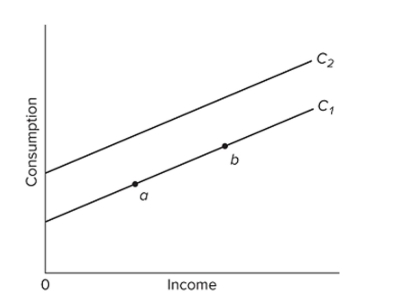 Refer to the given graph. A movement from b to a along C1 might be caused by a(n)
Refer to the given graph. A movement from b to a along C1 might be caused by a(n)A) recession.
B) wealth effect of an increase in stock market prices.
C) decrease in income tax rates.
D) increase in saving.

فتح الحزمة
افتح القفل للوصول البطاقات البالغ عددها 233 في هذه المجموعة.
فتح الحزمة
k this deck
42
The greater is the marginal propensity to consume, the
A) smaller is the marginal propensity to save.
B) higher is the interest rate.
C) smaller is the average propensity to consume.
D) lower is the price level.
A) smaller is the marginal propensity to save.
B) higher is the interest rate.
C) smaller is the average propensity to consume.
D) lower is the price level.

فتح الحزمة
افتح القفل للوصول البطاقات البالغ عددها 233 في هذه المجموعة.
فتح الحزمة
k this deck
43
When consumption and saving are graphed relative to real GDP, an increase in personal taxes will shift
A) both the consumption and saving schedules downward.
B) both the consumption and saving schedules upward.
C) the consumption schedule upward and the saving schedule downward.
D) the consumption schedule downward and the saving schedule upward.
A) both the consumption and saving schedules downward.
B) both the consumption and saving schedules upward.
C) the consumption schedule upward and the saving schedule downward.
D) the consumption schedule downward and the saving schedule upward.

فتح الحزمة
افتح القفل للوصول البطاقات البالغ عددها 233 في هذه المجموعة.
فتح الحزمة
k this deck
44
Given the consumption schedule, it is possible to graph the relevant saving schedule by
A) subtracting the MPC from 1 at each level of income.
B) subtracting investment from consumption at each level of GDP.
C) plotting the horizontal differences between the consumption schedule and the 45-degree line.
D) plotting the vertical differences between the consumption schedule and the 45-degree line.
A) subtracting the MPC from 1 at each level of income.
B) subtracting investment from consumption at each level of GDP.
C) plotting the horizontal differences between the consumption schedule and the 45-degree line.
D) plotting the vertical differences between the consumption schedule and the 45-degree line.

فتح الحزمة
افتح القفل للوصول البطاقات البالغ عددها 233 في هذه المجموعة.
فتح الحزمة
k this deck
45
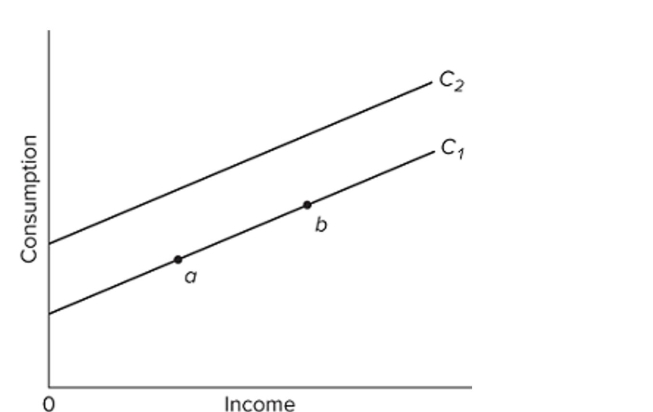 Refer to the given graph. A shift of the consumption schedule from C1 to C2 might be caused by a(n)
Refer to the given graph. A shift of the consumption schedule from C1 to C2 might be caused by a(n)A) recession.
B) wealth effect of an increase in stock market prices.
C) increase in income tax rates.
D) increase in saving.

فتح الحزمة
افتح القفل للوصول البطاقات البالغ عددها 233 في هذه المجموعة.
فتح الحزمة
k this deck
46
At the point where the consumption schedule intersects the 45-degree line,
A) the MPC equals 1.
B) the APC is zero.
C) saving equals income.
D) saving is zero.
A) the MPC equals 1.
B) the APC is zero.
C) saving equals income.
D) saving is zero.

فتح الحزمة
افتح القفل للوصول البطاقات البالغ عددها 233 في هذه المجموعة.
فتح الحزمة
k this deck
47
An upward shift of the saving schedule suggests
A) nothing with respect to changes in the APC and APS; only that the MPS has changed.
B) that the APC and APS have both decreased at each GDP level.
C) that the APC and APS have both increased at each GDP level.
D) that the APC has decreased and the APS has increased at each GDP level.
A) nothing with respect to changes in the APC and APS; only that the MPS has changed.
B) that the APC and APS have both decreased at each GDP level.
C) that the APC and APS have both increased at each GDP level.
D) that the APC has decreased and the APS has increased at each GDP level.

فتح الحزمة
افتح القفل للوصول البطاقات البالغ عددها 233 في هذه المجموعة.
فتح الحزمة
k this deck
48
The wealth effect is shown graphically as a
A) shift of the consumption schedule.
B) movement along an existing consumption schedule.
C) shift of the investment schedule.
D) movement along an existing investment schedule.
A) shift of the consumption schedule.
B) movement along an existing consumption schedule.
C) shift of the investment schedule.
D) movement along an existing investment schedule.

فتح الحزمة
افتح القفل للوصول البطاقات البالغ عددها 233 في هذه المجموعة.
فتح الحزمة
k this deck
49
The saving schedule is such that as aggregate income increases by a certain amount, saving
A) increases by the same amount as the increase in income.
B) does not change.
C) increases, but by a smaller amount.
D) increases by an even larger amount.
A) increases by the same amount as the increase in income.
B) does not change.
C) increases, but by a smaller amount.
D) increases by an even larger amount.

فتح الحزمة
افتح القفل للوصول البطاقات البالغ عددها 233 في هذه المجموعة.
فتح الحزمة
k this deck
50
Which of the following will not cause the consumption schedule to shift?
A) a sharp increase in the amount of wealth held by households
B) a change in consumer incomes
C) the expectation of a recession
D) a growing expectation that consumer durables will be increasing in price soon
A) a sharp increase in the amount of wealth held by households
B) a change in consumer incomes
C) the expectation of a recession
D) a growing expectation that consumer durables will be increasing in price soon

فتح الحزمة
افتح القفل للوصول البطاقات البالغ عددها 233 في هذه المجموعة.
فتح الحزمة
k this deck
51
If the saving schedule is a straight line, the
A) MPS must be constant.
B) APS must be constant.
C) APC must be constant.
D) MPC must be rising.
A) MPS must be constant.
B) APS must be constant.
C) APC must be constant.
D) MPC must be rising.

فتح الحزمة
افتح القفل للوصول البطاقات البالغ عددها 233 في هذه المجموعة.
فتح الحزمة
k this deck
52
Which of the following will not tend to shift the consumption schedule upward?
A) a currently small stock of durable goods in the possession of consumers
B) the expectation of a future decline in the consumer price index
C) a currently low level of household debt
D) the expectation of future shortages of essential consumer goods
A) a currently small stock of durable goods in the possession of consumers
B) the expectation of a future decline in the consumer price index
C) a currently low level of household debt
D) the expectation of future shortages of essential consumer goods

فتح الحزمة
افتح القفل للوصول البطاقات البالغ عددها 233 في هذه المجموعة.
فتح الحزمة
k this deck
53
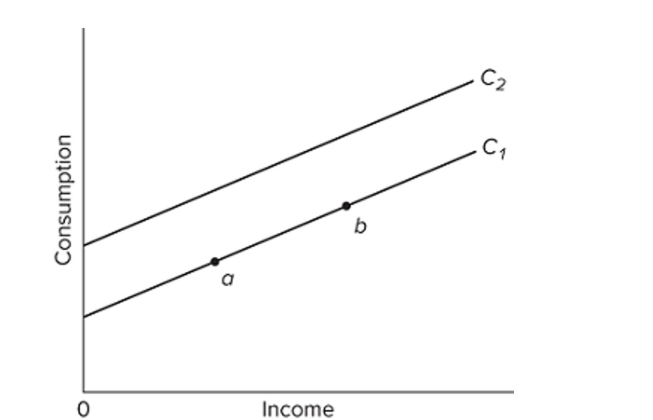 Refer to the given graph. A movement from a to b along C1 might be caused by a(n)
Refer to the given graph. A movement from a to b along C1 might be caused by a(n)A) recession.
B) wealth effect of an increase in stock market prices.
C) increase in income tax rates.
D) increase in real GDP.

فتح الحزمة
افتح القفل للوصول البطاقات البالغ عددها 233 في هذه المجموعة.
فتح الحزمة
k this deck
54
Which one of the following will cause a movement up along an economy's saving schedule?
A) an increase in household borrowing
B) an increase in disposable income
C) an increase in stock prices
D) an increase in interest rates
A) an increase in household borrowing
B) an increase in disposable income
C) an increase in stock prices
D) an increase in interest rates

فتح الحزمة
افتح القفل للوصول البطاقات البالغ عددها 233 في هذه المجموعة.
فتح الحزمة
k this deck
55
If the consumption schedule shifts upward and the shift was not caused by a tax change, the saving schedule
A) will not shift.
B) may shift either upward or downward.
C) will shift downward.
D) will also shift upward.
A) will not shift.
B) may shift either upward or downward.
C) will shift downward.
D) will also shift upward.

فتح الحزمة
افتح القفل للوصول البطاقات البالغ عددها 233 في هذه المجموعة.
فتح الحزمة
k this deck
56
If the consumption schedule is linear, then the
A) saving schedule will also be linear.
B) MPS will decline as income rises.
C) MPC will decline as income rises.
D) APC will be constant at all levels of income.
A) saving schedule will also be linear.
B) MPS will decline as income rises.
C) MPC will decline as income rises.
D) APC will be constant at all levels of income.

فتح الحزمة
افتح القفل للوصول البطاقات البالغ عددها 233 في هذه المجموعة.
فتح الحزمة
k this deck
57
If for some reason households become increasingly thrifty, we could show this by
A) a downshift of the saving schedule.
B) an upward shift of the consumption schedule.
C) an upward shift of the saving schedule.
D) a movement down along a stable consumption function.
A) a downshift of the saving schedule.
B) an upward shift of the consumption schedule.
C) an upward shift of the saving schedule.
D) a movement down along a stable consumption function.

فتح الحزمة
افتح القفل للوصول البطاقات البالغ عددها 233 في هذه المجموعة.
فتح الحزمة
k this deck
58
 Refer to the given graph. A shift of the consumption schedule from C2 to C1 might be caused by a(n)
Refer to the given graph. A shift of the consumption schedule from C2 to C1 might be caused by a(n)A) increase in real GDP.
B) reverse wealth effect, caused by a decrease in stock market prices.
C) decrease in income tax rates.
D) decrease in saving.

فتح الحزمة
افتح القفل للوصول البطاقات البالغ عددها 233 في هذه المجموعة.
فتح الحزمة
k this deck
59
If the marginal propensity to consume is 0.9, then the marginal propensity to save must be
A) 1.0
B) 0.1.
C) 1.1.
D) 0.9.
A) 1.0
B) 0.1.
C) 1.1.
D) 0.9.

فتح الحزمة
افتح القفل للوصول البطاقات البالغ عددها 233 في هذه المجموعة.
فتح الحزمة
k this deck
60
In the late 1990s, the U.S. stock market boomed, causing U.S. consumption to rise. Economists refer to this outcome as the
A) Keynes effect.
B) interest-rate effect.
C) wealth effect.
D) multiplier effect.
A) Keynes effect.
B) interest-rate effect.
C) wealth effect.
D) multiplier effect.

فتح الحزمة
افتح القفل للوصول البطاقات البالغ عددها 233 في هذه المجموعة.
فتح الحزمة
k this deck
61
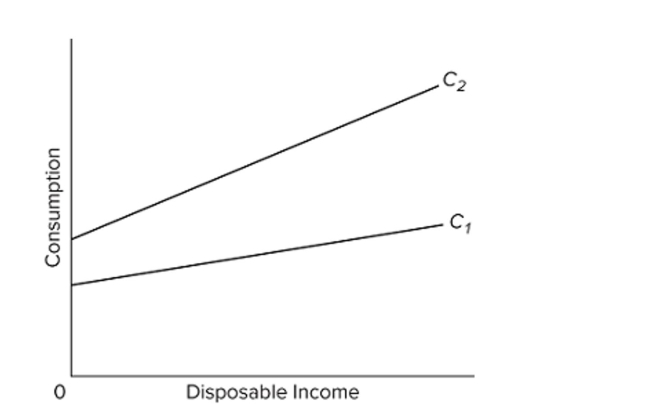 Suppose an economy's consumption schedule shifts from C1 to C2, as shown in the diagram. We can say that its
Suppose an economy's consumption schedule shifts from C1 to C2, as shown in the diagram. We can say that itsA) MPC has increased, but its APC at each income level is unchanged.
B) APC at each income level is increased, but its MPC is unchanged.
C) MPC and APC at each income level have both increased.
D) MPC and APC at each income level have both decreased.

فتح الحزمة
افتح القفل للوصول البطاقات البالغ عددها 233 في هذه المجموعة.
فتح الحزمة
k this deck
62
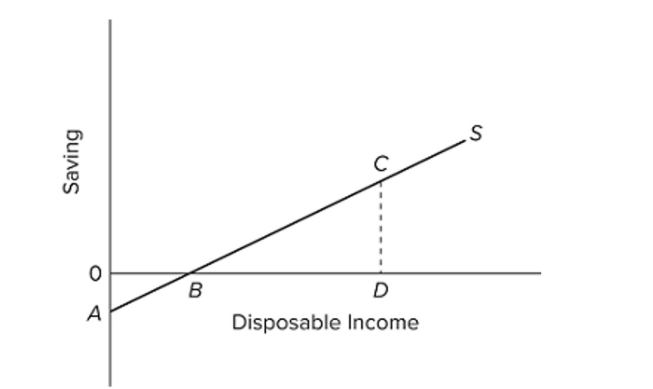 Refer to the diagram. At disposable income level D, consumption is equal to
Refer to the diagram. At disposable income level D, consumption is equal toA) CD.
B) D minus CD.
C) CD/D.
D) CD plus BD.

فتح الحزمة
افتح القفل للوصول البطاقات البالغ عددها 233 في هذه المجموعة.
فتح الحزمة
k this deck
63
Refer to the given data for a hypothetical economy. At the $100 level of income, the average propensity to save is
A) 0.10.
B) 0.20.
C) 0.25.
D) 0.90.
A) 0.10.
B) 0.20.
C) 0.25.
D) 0.90.

فتح الحزمة
افتح القفل للوصول البطاقات البالغ عددها 233 في هذه المجموعة.
فتح الحزمة
k this deck
64
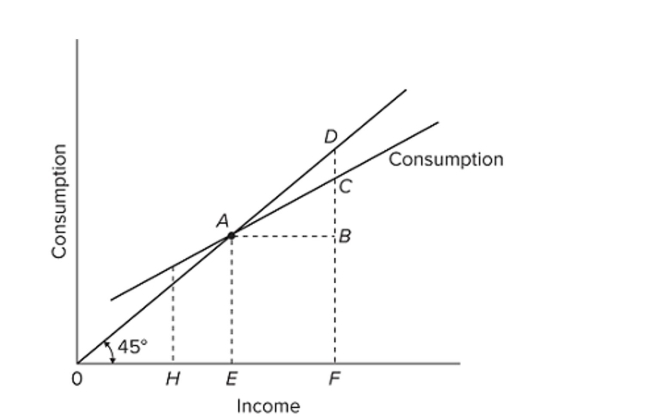 Refer to the given diagram. Consumption will be equal to income at
Refer to the given diagram. Consumption will be equal to income atA) an income of E.
B) an income of F.
C) point C.
D) point D.

فتح الحزمة
افتح القفل للوصول البطاقات البالغ عددها 233 في هذه المجموعة.
فتح الحزمة
k this deck
65
Refer to the given data. At the $200 level of disposable income,
A) the marginal propensity to save is 2½ percent.
B) dissaving is $5.
C) the average propensity to save is 0.20.
D) the average propensity to consume is 0.80.
A) the marginal propensity to save is 2½ percent.
B) dissaving is $5.
C) the average propensity to save is 0.20.
D) the average propensity to consume is 0.80.

فتح الحزمة
افتح القفل للوصول البطاقات البالغ عددها 233 في هذه المجموعة.
فتح الحزمة
k this deck
66
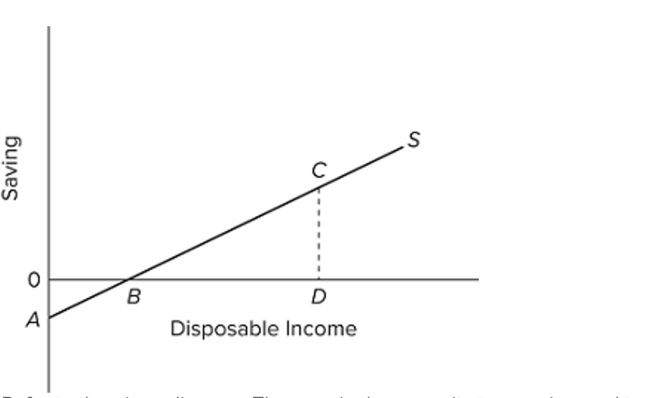 Refer to the given diagram. The marginal propensity to save is equal to
Refer to the given diagram. The marginal propensity to save is equal toA) CD/0D.
B) 0B/0A.
C) 0A/0D.
D) CD/BD.

فتح الحزمة
افتح القفل للوصول البطاقات البالغ عددها 233 في هذه المجموعة.
فتح الحزمة
k this deck
67
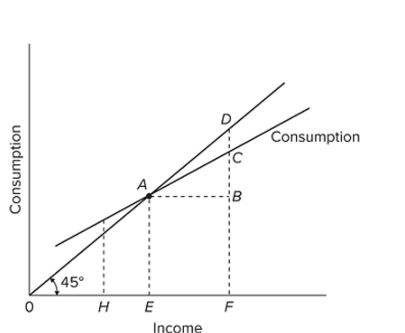 Refer to the given diagram. At income level F, the volume of saving is
Refer to the given diagram. At income level F, the volume of saving isA) BD.
B) AB.
C) CF − BF.
D) CD.

فتح الحزمة
افتح القفل للوصول البطاقات البالغ عددها 233 في هذه المجموعة.
فتح الحزمة
k this deck
68
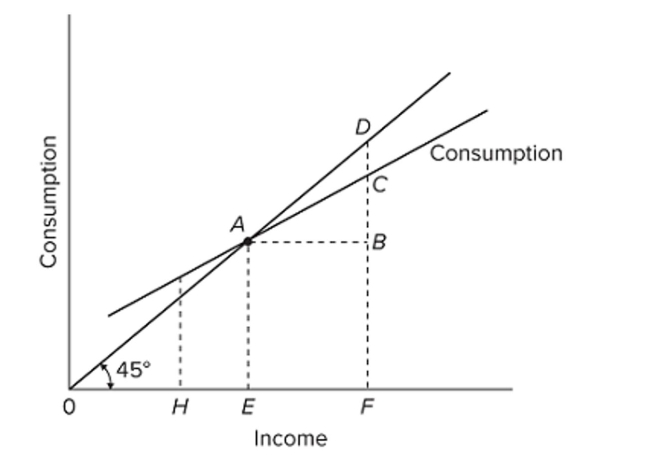 Refer to the given diagram. The marginal propensity to save is
Refer to the given diagram. The marginal propensity to save isA) CD/EF.
B) CB/CF.
C) CB/AF.
D) EF/CB.

فتح الحزمة
افتح القفل للوصول البطاقات البالغ عددها 233 في هذه المجموعة.
فتح الحزمة
k this deck
69
Refer to the given data. The marginal propensity to consume is
A) 0.25.
B) 0.75.
C) 0.20.
D) 0.80.
A) 0.25.
B) 0.75.
C) 0.20.
D) 0.80.

فتح الحزمة
افتح القفل للوصول البطاقات البالغ عددها 233 في هذه المجموعة.
فتح الحزمة
k this deck
70
Refer to the given data for a hypothetical economy. The marginal propensity to consume is
A) 0.80.
B) 0.75.
C) 0.20.
D) 0.25.
A) 0.80.
B) 0.75.
C) 0.20.
D) 0.25.

فتح الحزمة
افتح القفل للوصول البطاقات البالغ عددها 233 في هذه المجموعة.
فتح الحزمة
k this deck
71
Refer to the given data. If disposable income was $325, we would expect consumption to be
A) $315.
B) $305.
C) $20.
D) $290.
A) $315.
B) $305.
C) $20.
D) $290.

فتح الحزمة
افتح القفل للوصول البطاقات البالغ عددها 233 في هذه المجموعة.
فتح الحزمة
k this deck
72
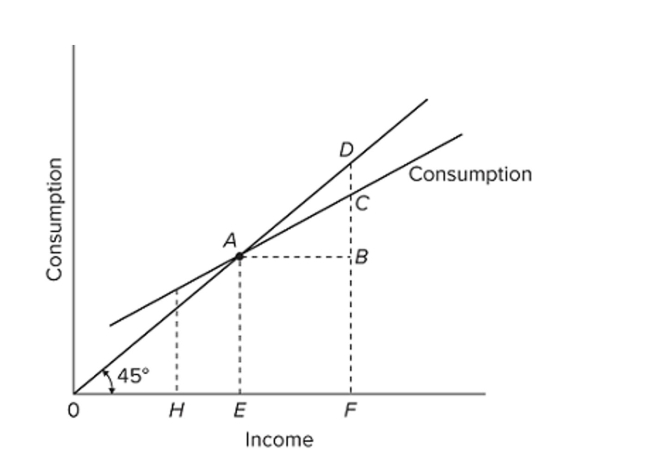 Refer to the given diagram. The marginal propensity to consume is equal to
Refer to the given diagram. The marginal propensity to consume is equal toA) AE/0E.
B) CF/CD.
C) CB/AB.
D) CD/CF.

فتح الحزمة
افتح القفل للوصول البطاقات البالغ عددها 233 في هذه المجموعة.
فتح الحزمة
k this deck
73
 Suppose the economy's saving schedule shifts from S1 to S2, as shown in the given diagram. We can say that its
Suppose the economy's saving schedule shifts from S1 to S2, as shown in the given diagram. We can say that itsA) MPC has increased.
B) MPS has increased.
C) APS has increased at all levels of disposable income.
D) APS has decreased at all levels of disposable income.

فتح الحزمة
افتح القفل للوصول البطاقات البالغ عددها 233 في هذه المجموعة.
فتح الحزمة
k this deck
74
 Refer to the given diagram. The economy is dissaving
Refer to the given diagram. The economy is dissavingA) in the amount CD.
B) at all income levels greater than E.
C) at income level H.
D) at income level E.

فتح الحزمة
افتح القفل للوصول البطاقات البالغ عددها 233 في هذه المجموعة.
فتح الحزمة
k this deck
75
 Refer to the given figure. If the relevant saving schedule were constructed,
Refer to the given figure. If the relevant saving schedule were constructed,A) saving would be minus $20 billion at the zero level of income.
B) aggregate saving would be $60 at the $60 billion level of income.
C) its slope would be 1/2.
D) it would slope downward and to the right.

فتح الحزمة
افتح القفل للوصول البطاقات البالغ عددها 233 في هذه المجموعة.
فتح الحزمة
k this deck
76
 The given figure suggests that
The given figure suggests thatA) consumption would be $60 billion even if income were zero.
B) saving is zero at the $120 billion income level.
C) as income increases, consumption decreases as a percentage of income.
D) as income increases, consumption decreases absolutely.

فتح الحزمة
افتح القفل للوصول البطاقات البالغ عددها 233 في هذه المجموعة.
فتح الحزمة
k this deck
77
Assume the economy's consumption and saving schedules simultaneously shift downward. This must be the result of
A) an increase in disposable income.
B) an increase in household wealth.
C) an increase in personal taxes.
D) the expectation of a recession.
A) an increase in disposable income.
B) an increase in household wealth.
C) an increase in personal taxes.
D) the expectation of a recession.

فتح الحزمة
افتح القفل للوصول البطاقات البالغ عددها 233 في هذه المجموعة.
فتح الحزمة
k this deck
78
Refer to the given data for a hypothetical economy. If plotted on a graph, the slope of the saving schedule would be
A) 0.80.
B) 0.10.
C) 0.20.
D) 0.15.
A) 0.80.
B) 0.10.
C) 0.20.
D) 0.15.

فتح الحزمة
افتح القفل للوصول البطاقات البالغ عددها 233 في هذه المجموعة.
فتح الحزمة
k this deck
79
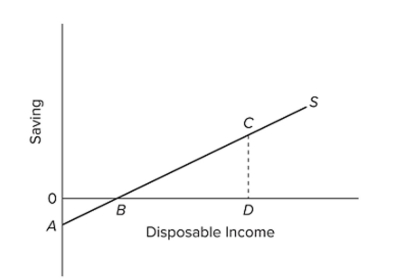 Refer to the diagram. At disposable income level D, the average propensity to save is equal to
Refer to the diagram. At disposable income level D, the average propensity to save is equal toA) CD/BD.
B) CD/0D.
C) 0D/CD.
D) 0A/0B.

فتح الحزمة
افتح القفل للوصول البطاقات البالغ عددها 233 في هذه المجموعة.
فتح الحزمة
k this deck
80
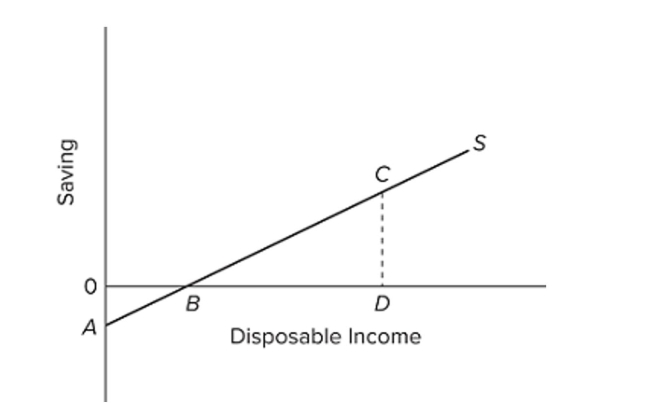 Refer to the diagram. Consumption equals disposable income when
Refer to the diagram. Consumption equals disposable income whenA) disposable income is B.
B) disposable income is D.
C) CD equals A.
D) B equals CD.

فتح الحزمة
افتح القفل للوصول البطاقات البالغ عددها 233 في هذه المجموعة.
فتح الحزمة
k this deck








